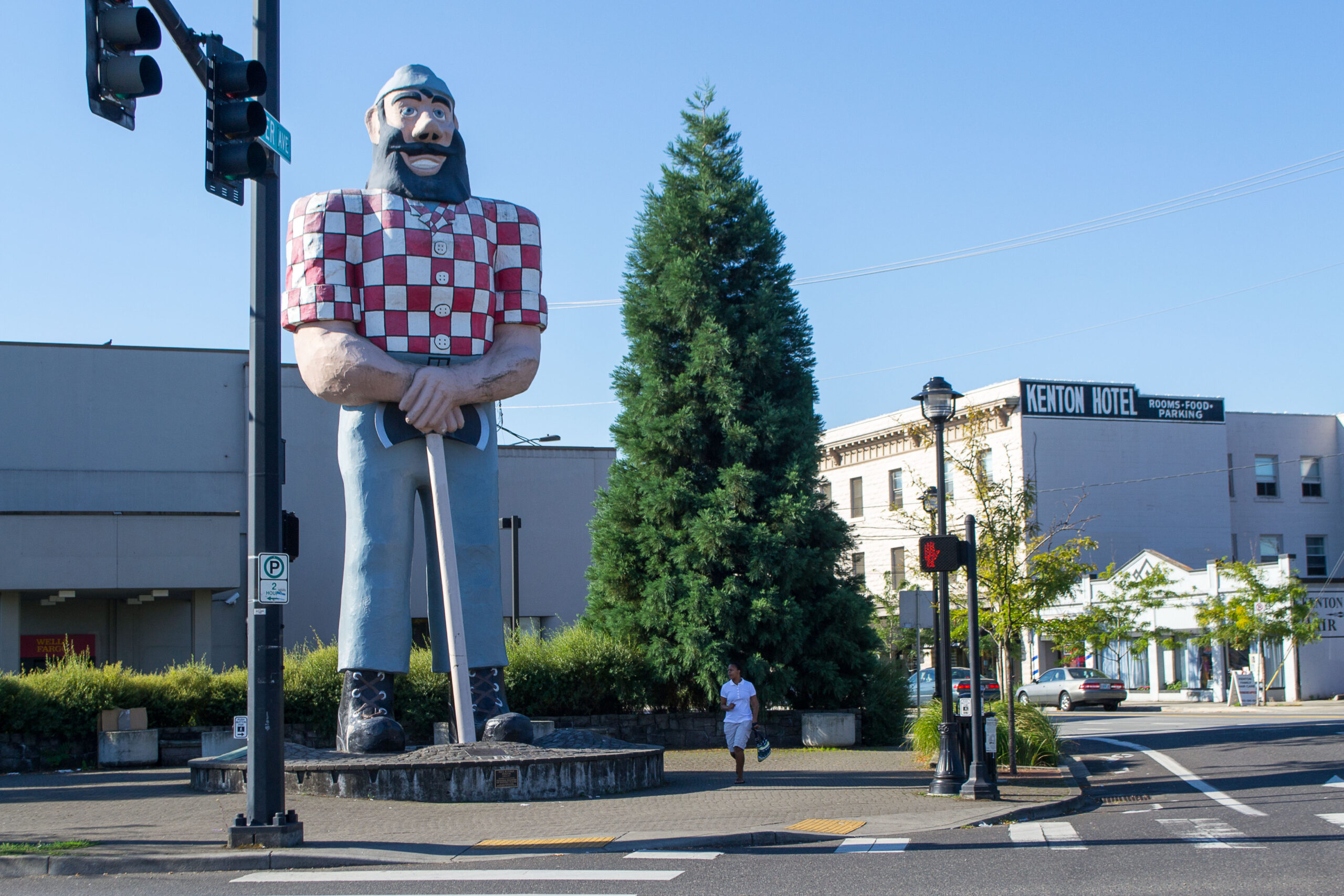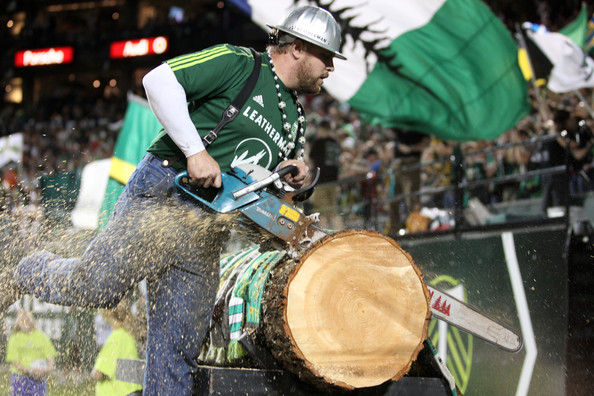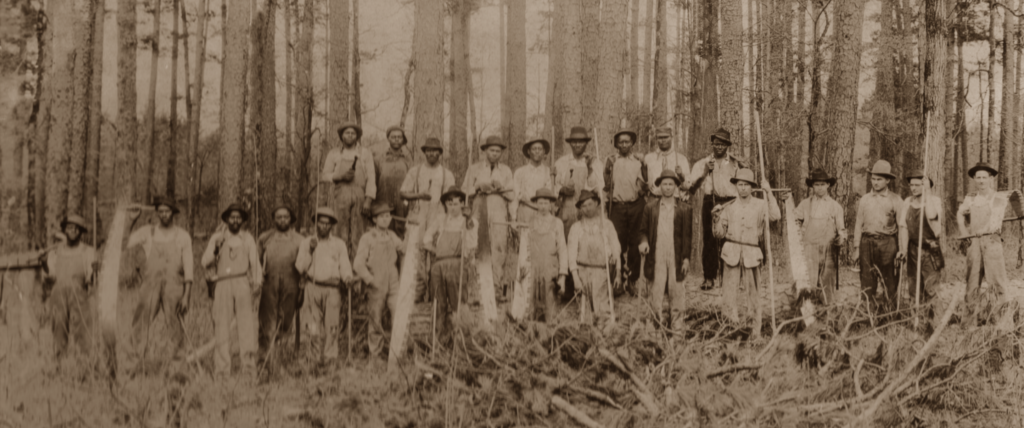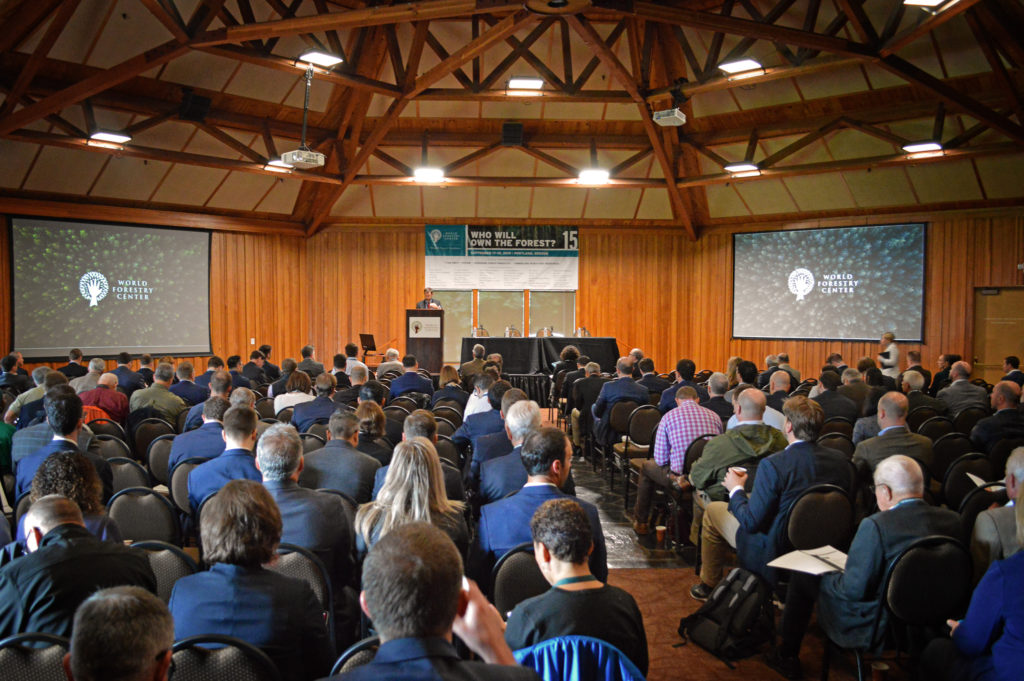
As Portlanders and Oregonians, it is not uncommon to encounter references to forestry in our everyday lives. The Timbers soccer team, Stumptown Coffee Roasters, and local hotspots and brands like Doug Fir Lounge and Great Notion Beer all employ forestry terms and aesthetics to reinforce their Portland bona fides.
When did Oregon and forestry become synonymous?
Before white settlers arrived in Oregon, it was home to over 20 indigenous tribes whose people lived symbiotically with the land, maintained the forests, and worked to preserve the environment around them.
As a territory, Oregon was shaped through manipulation of land by United States government. The Donation Land Act of 1850 dispossessed Indigenous Peoples and pushed white settlers into the territory. White males and married white women were allotted a 320 acre plot of land in Oregon. Conflict erupted between these white settlers and Native Peoples; many tribes did not survive the wars. In 1854, U.S. army troops forcibly relocated most surviving tribal bands to a newly established coastal reservation. The Act expired in 1855, but resulted in a huge increase in Oregon’s population of white settlers.
Today, there are only nine federally recognized tribes within the state. However, they continue play a crucial role in the maintenance of forested lands and passing on indigenous knowledge to other state residents.

The timber industry in Oregon grew alongside the California Gold Rush of the 1800s. As more white settlers moved west hoping to strike it rich, the need for lumber increased. When rail lines were extended into Oregon in the 1870-80s, the Ponderosa Pines of Eastern Oregon and the forested areas of the Western Cascades were there to meet the need. Between the 1880s and 1911, more railways were added and logging boomed. By 1938, Oregon was the nation’s leading producer of wood. To this day, Oregon produces more wood building materials than any other state.
As Oregon, and its largest city, Portland, grew in the mid-1800s, more trees were cut to build homes. Because it was easier to leave the stumps instead of removing them, the city of Portland became known as Stumptown. Stumptown Coffee and the numerous other brands that use this moniker pay homage to Portland’s early logging history.
Other brands and organizations have also embraced the city’s logging history. The Portland Timbers was established in 1975 as part of the North American Soccer League (NASL). In 2011, the team earned a spot within Major League Soccer. Timbers’ fans, proudly called the “army,” celebrate their team with lumberjack-inspired apparel. Players’ jerseys sport an axe-shaped logo and the team’s woodsman mascot, Timber Joey, cuts rings from a Victory Log after every home goal.

Race and Forestry
Oregon’s Constitution originally included a racist provision that excluded free Black Americans from the state. It read that “No free Negro, or Mulatto, not residing in this state at the time of the adoption of this constitution, shall come, reside, or be within this state, or hold any real estate, or make any contracts, or maintain any suit therein.” The constitutional provision was only repealed in 1926.
This racist provision meant that most of Oregon’s early population and loggers were white. However, despite this prejudiced history, Black Americans and other people of color played a key part in our state’s logging industry.

Maxville, Oregon in Wallowa County was a home base for Oregon’s black logging population, as well as Greek, Japanese, and other loggers of color.Though the town and recreational activities were segregated, Black and white men worked side by side. Maxville was home to a vibrant logging community until the early-1930s, when lumber companies cut their holdings there and most families moved away. In the mid-1940s Maxville was destroyed by a storm.
An Evolving Economy

Oregon has been at the forefront of the development of logging practices since the very beginning. The state continues to lead the field. Originally loggers used the steam donkey to increase productivity, eventually trading it for electric tools.
Around 1925, when California’s demand for lumber fell, Oregon’s loggers began to suffer; mill closures and employee layoffs became commonplace by the beginning of the 1930s.
After World War II, however, Oregon’s logging industry boomed once again. The post-war increase in production brought a second wave of logging prosperity. New technology, specifically the modern chainsaw, further increased efficiency.
Timber Today
Logging still accounts for a significant portion of Oregon’s annual revenue. In 2019, Oregon made $86.9 million from timber sales. Today, over 61,000 Oregonians are employed in the forestry industry, and 47% of the state is considered forestland. The state is the top U.S. producer of both softwood lumber and plywood. And, more recently, Oregon has become a leader in manufacturing innovative “mass timber” engineered wood products such as cross-laminated timber (CLT) and Mass Plywood Panels (MPP).
Forestry has shaped the state in countless other, more subtle ways. Portland’s thriving arts, cultural, and non-profit organizations are indirectly supported by the timber industry, as many of the state’s largest philanthropic donors have financial roots in forestry.
Oregon remains a leader within the field of forestry development. Oregon State University’s College of Forestry is an internationally recognized leader in forestry education, the International Mass Timber Conference draws over 1,000 forestry experts to Portland each year, and World Forestry Center’s Who Will Own the Forest conference is one of the largest Timberland investing events in the world.

The roots of World Forestry Center date back to the 1905 Lewis and Clark Exposition, in which a massive log structure was built to house the Forestry Building. Since then, the non-profit has worked to create and inspire champions of sustainable forestry.
Almost every aspect of Oregon life has been influenced by the timber industry. It is considered “the wheel which sets all other wheels in motion.” New industries and businesses have continued to reference Portland’s forestry history when choosing brand names, logos, and images.
So, the next time that you see a new craft beer with a lumberjack on the logo, know that you have Oregon’s timber history to thank.
